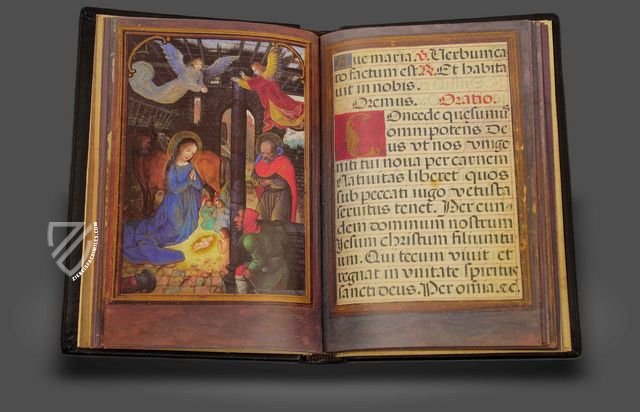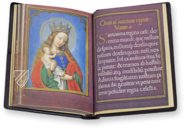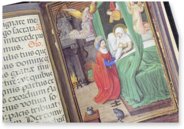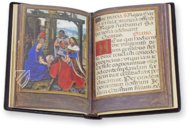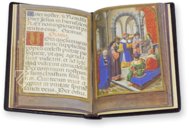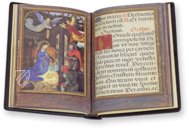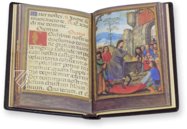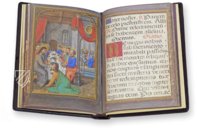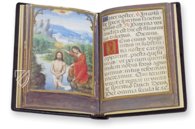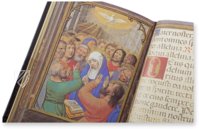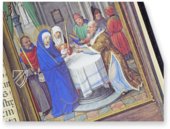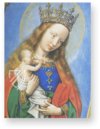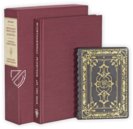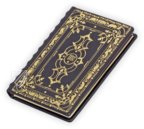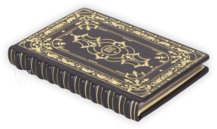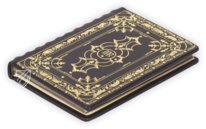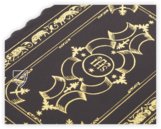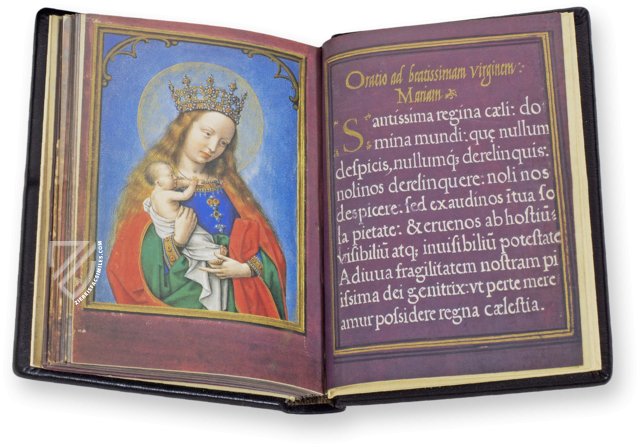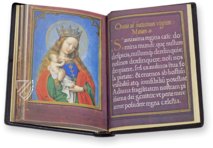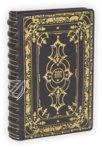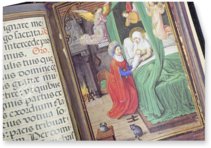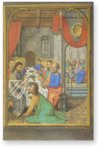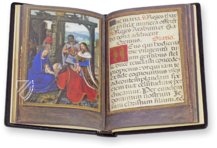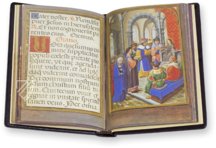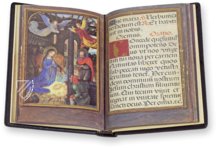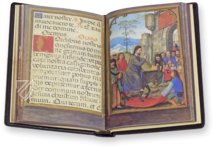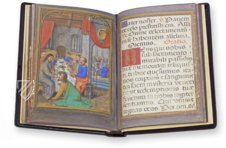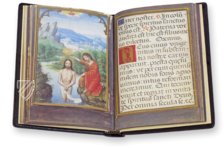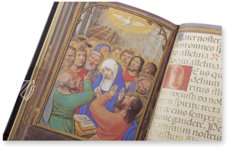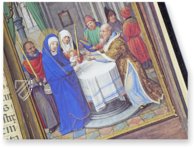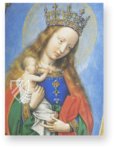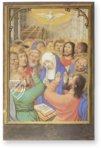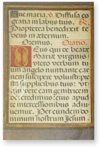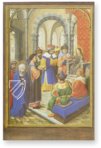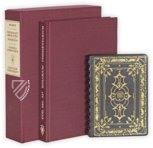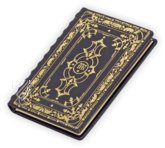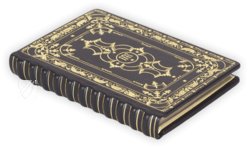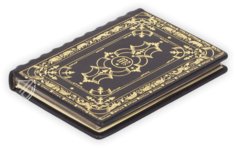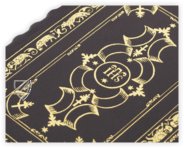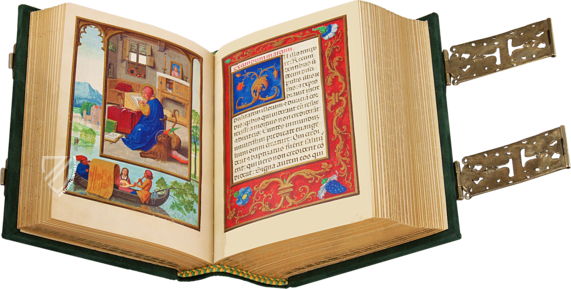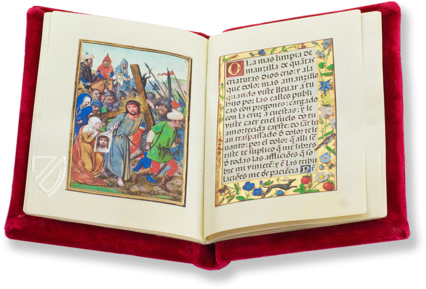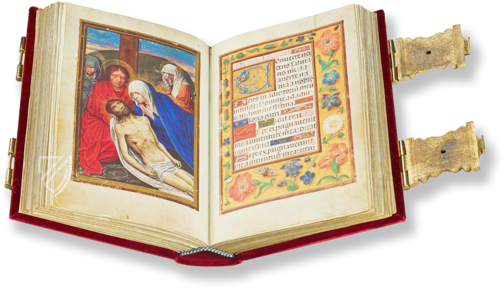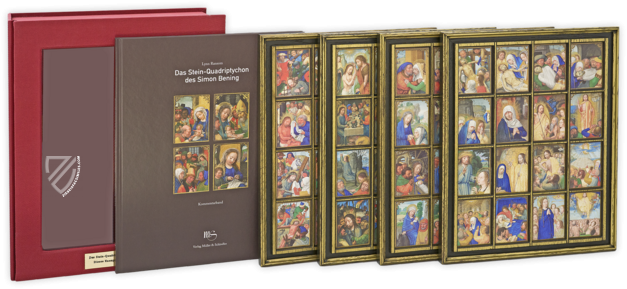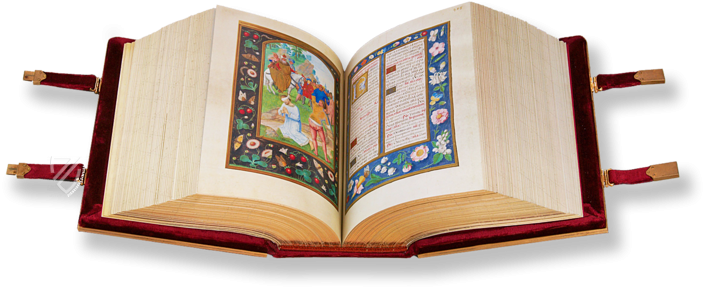Beatty Rosarium
(under 1,000€)
At the end of its 1000-year tradition, illumination still experienced a great flowering after the invention of printing. The last and probably greatest master of European illumination was Simon Bening (ca. 1483-1561), who created here a Marian prayer book, which contains one of only three completely preserved picture cycles from his hand. The prayer text and the 33 miniatures are innovative and uniquely related to each other. For example, the prayer text for the story of the 12-year-old Jesus in the temple asks that God's people recognize what needs to be done and find strength to do it. In the accompanying miniature, Bening paints the facial expressions of the individual scholars in the temple, from positively amazed to annoyed, so individually that the viewer can ask himself which of the many reactions is his own – and what is to be done for him.
Beatty Rosarium
The Rosary in the Dublin Chester Beatty Library is a small prayer book which is notable for several reasons, not least for the high artistic quality of its 33 full page miniatures attributed to the last and greatest Flemish book painter, Simon Bening (1483–1561). The text, however, also merits great attention for a compilation of diverse prayers to God and the Saints as well as to the Blessed Virgin Mary. Although both miniatures and text go back to earlier sources, the individual elements of the Beatty Rosarium are arranged in such a way that our work constitutes an innovative and unique prayer book. The reader is surprised by the great number of miniatures illustrating the text and supporting its contents in an ideal manner. This draws the attention both to the devotional contents of the prayer and the illustration at the same time. The extraordinary beauty of the miniatures at one stage resulted in their having been removed from their binding and sold separately. By a remarkable piece of good fortune, however, they were returned, were bound again with the text pages and have been preserved as a whole book ever since.
Simon Bening – Last Master of Flemish Illumination
The Beatty Rosary was probably made ca. 1530 and constitutes one of the last masterworks in the 1000-year-old tradition of illumination. It is very rare that a prayer book holding a cycle of miniatures was executed exclusively by a single hand, in our case, Simon Bening’s. This illuminator continuously followed the work of his colleagues. His creations are based on a wealth of earlier compositions and composition details that he assembled during his active life and used extensively in countless variations. This presents him not as eclectic, but rather as a genuine creative artist.
A "Rose Garden" of Devotional Prayers
In the Middle Ages, the term of Rosarium, which in classical Latin signifies "rose garden", acquired the meaning of a text collection, which we would today call an anthology. In the 14th century, however, the word was widely used as a title for prayer books on the Blessed Virgin Mary, undoubtedly because "the rose was a very popular symbol of the Virgin". In the Christian Middle Ages, people liked to look at a picture while reading a text, and to meditate on it. The Beatty Rosary seems to have been very appropriate in this respect, as the full page miniatures facing the text were particularly suited to this devotional practice. With the exception of the first 16 text pages, each page of text is faced by a miniature, enabling the person in prayer to sink in meditation before the picture while reading the text. The Rosary was compiled by Simon Bening, who chose passages from well-known religious texts and matched them in an unusual manner with miniatures which fascinate in the luminosity of their colors, fine details, representation of space, landscape painting, and emotional expression.
A Prayer Book for a Spanish King
Although there are only indirect indications as to the identity of the first owner of the manuscript, some stylistic elements of script and the addition of a guard-sheet with Spanish text suggests a Spanish patron. With its combination of Flemish miniatures and Spanish script, the Rosarywidens our current knowledge on artistic links between Spain and Flanders in the 16th century. Moreover, two flyleaves containing inscriptions refer to its former owners and inform us on the provenance of the work, one of them making us assume that the book once belonged to King Philip II of Spain.
Codicology
- Alternative Titles
- Das Rosarium
- Size / Format
- 106 pages / 12.4 × 8.4 cm
- Origin
- Belgium
- Date
- Ca. 1530
- Epochs
- Style
- Genre
- Illustrations
- 33 full-page miniatures with gold ornaments
- Patron
- Probably Philip II, King of Spain
- Artist / School
- Simon Bening (illuminator)
Beatty Rosarium
Disputation with the Doctors
In a typical medieval depiction of this scene from the Gospel of Luke, Christ is shown seated on a raised dais and gesturing as though he is lecturing and surrounded by elders who frown and exchange disapproving glances while consulting books. They serve as fine subjects for the Flemish master Simon Bening because of their lavish clothing, which is bright, multi-layered, and includes fur-lined hats and collars. Although twelve in the story, Christ looks much younger here.
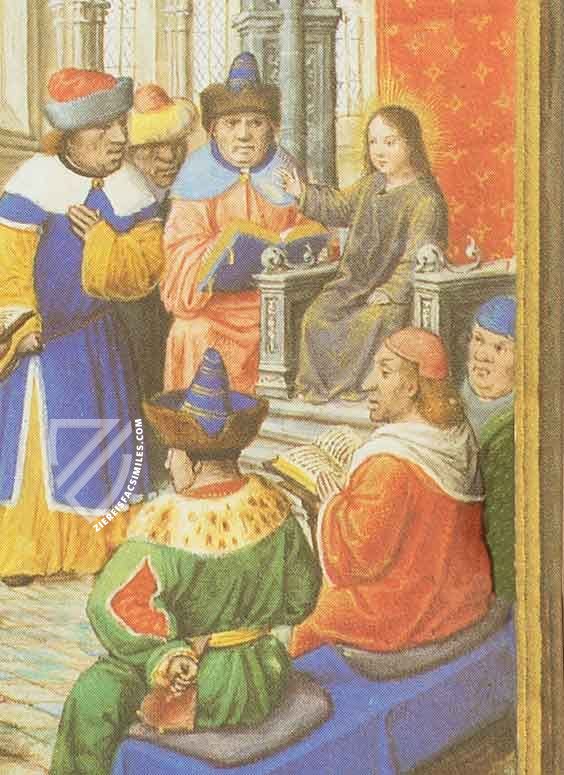
Beatty Rosarium
The Pentecost
This is one of only three complete image cycles to come exclusively from the hand of Simon Bening. Each miniature resembles a small, independent panel painting but they are consistent stylistically, sharing luminous colors, fine details and spatiality, and emotional expressions.
This depiction of the Pentecost, when the Holy Spirit descended upon the followers of Jesus Christ in the form of a dove, occurs in a contemporary church. Gold leaf radiates from the dove and reigns down upon the crowd of haloed faces, who look up in wonder, except for the Virgin Mary, who is squarely in the center of the image. Hands held up in prayer, face still exhibiting the sorrow of her loss, her gaze is focused on a book in front of her, possibly the manuscript at hand.
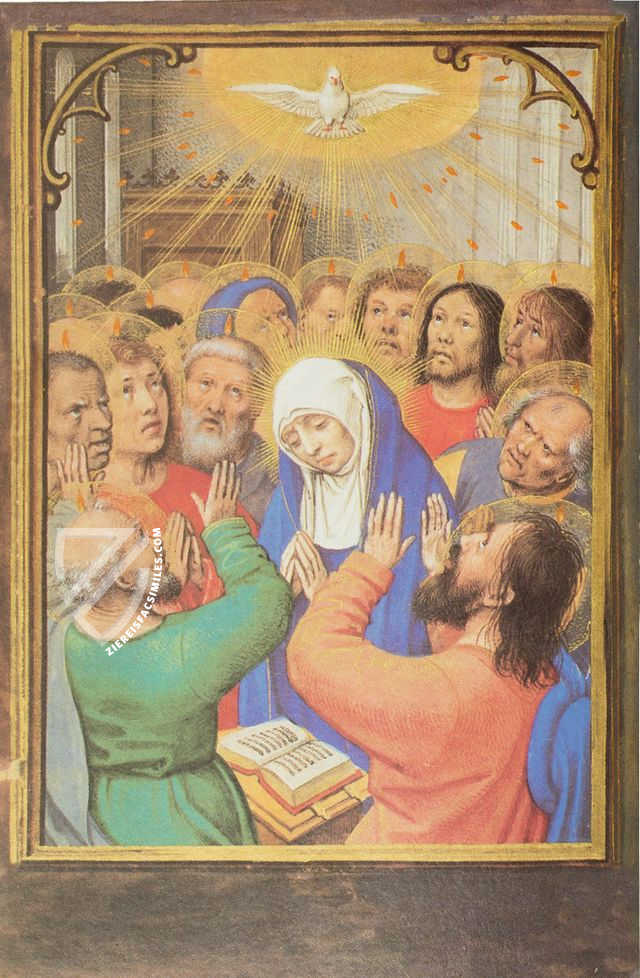
#1 Das Rosarium
Language: German
267 pages with numerous illustrations (translated into German).
The scholarly commentary, written by Judith Testa and edited by James Marrow, examines the manuscript from various angles and describes its environment. There are articles on the type of rosary, the book painter Simon Bening and his œuvre, the significance of the Beatty Rosary in the history of art as well as a codicological analysis. The commentary volume is complete with a transcription and translation of the Latin text (by Philipp Harnoncourt and Friederike Kiedl) and an extensive description of all 33 miniatures.
(under 1,000€)
- Treatises / Secular Books
- Apocalypses / Beatus
- Astronomy / Astrology
- Bestiaries
- Bibles / Gospels
- Chronicles / History / Law
- Geography / Maps
- Saints' Lives
- Islam / Oriental
- Judaism / Hebrew
- Single Leaf Collections
- Leonardo da Vinci
- Literature / Poetry
- Liturgical Manuscripts
- Medicine / Botany / Alchemy
- Music
- Mythology / Prophecies
- Psalters
- Other Religious Books
- Games / Hunting
- Private Devotion Books
- Other Genres
- Afghanistan
- Armenia
- Austria
- Belgium
- Belize
- Bosnia and Herzegovina
- China
- Colombia
- Costa Rica
- Croatia
- Cyprus
- Czech Republic
- Denmark
- Egypt
- El Salvador
- Ethiopia
- France
- Germany
- Greece
- Guatemala
- Honduras
- Hungary
- India
- Iran
- Iraq
- Israel
- Italy
- Japan
- Jordan
- Kazakhstan
- Kyrgyzstan
- Lebanon
- Liechtenstein
- Luxembourg
- Mexico
- Morocco
- Netherlands
- Palestine
- Panama
- Peru
- Poland
- Portugal
- Romania
- Russia
- Serbia
- Spain
- Sri Lanka
- Sweden
- Switzerland
- Syria
- Tajikistan
- Turkey
- Turkmenistan
- Ukraine
- United Kingdom
- United States
- Uzbekistan
- Vatican City
- A. Oosthoek, van Holkema & Warendorf
- Aboca Museum
- Ajuntament de Valencia
- Akademie Verlag
- Akademische Druck- u. Verlagsanstalt (ADEVA)
- Aldo Ausilio Editore - Bottega d’Erasmo
- Alecto Historical Editions
- Alkuin Verlag
- Almqvist & Wiksell
- Amilcare Pizzi
- Andreas & Andreas Verlagsbuchhandlung
- Archa 90
- Archiv Verlag
- Archivi Edizioni
- Arnold Verlag
- ARS
- Ars Magna
- ArtCodex
- AyN Ediciones
- Azimuth Editions
- Badenia Verlag
- Bärenreiter-Verlag
- Belser Verlag
- Belser Verlag / WK Wertkontor
- Benziger Verlag
- Bernardinum Wydawnictwo
- BiblioGemma
- Biblioteca Apostolica Vaticana (Vaticanstadt, Vaticanstadt)
- Bibliotheca Palatina Faksimile Verlag
- Bibliotheca Rara
- Boydell & Brewer
- Bramante Edizioni
- Bredius Genootschap
- Brepols Publishers
- British Library
- C. Weckesser
- Caixa Catalunya
- Canesi
- CAPSA, Ars Scriptoria
- Caratzas Brothers, Publishers
- Carus Verlag
- Casamassima Libri
- Centrum Cartographie Verlag GmbH
- Chavane Verlag
- Christian Brandstätter Verlag
- Circulo Cientifico
- Club Bibliófilo Versol
- Club du Livre
- CM Editores
- Collegium Graphicum
- Collezione Apocrifa Da Vinci
- Comissão Nacional para as Comemorações dos Descobrimentos Portugueses
- Coron Verlag
- Corvina
- CTHS
- D. S. Brewer
- Damon
- De Agostini/UTET
- De Nederlandsche Boekhandel
- De Schutter
- Deuschle & Stemmle
- Deutscher Verlag für Kunstwissenschaft
- DIAMM
- Droz
- E. Schreiber Graphische Kunstanstalten
- Ediciones Boreal
- Ediciones Grial
- Ediclube
- Edições Inapa
- Edilan
- Editalia
- Edition Deuschle
- Edition Georg Popp
- Edition Leipzig
- Edition Libri Illustri
- Editiones Reales Sitios S. L.
- Éditions de l'Oiseau Lyre
- Editions Medicina Rara
- Editorial Casariego
- Editorial Mintzoa
- Editrice Antenore
- Editrice Velar
- Edizioni Edison
- Egeria, S.L.
- Eikon Editores
- Electa
- Emery Walker Limited
- Enciclopèdia Catalana
- Eos-Verlag
- Ephesus Publishing
- Ernst Battenberg
- Eugrammia Press
- Extraordinary Editions
- Fackelverlag
- Facsimila Art & Edition
- Facsimile Editions Ltd.
- Facsimilia Art & Edition Ebert KG
- Faksimile Verlag
- Feuermann Verlag
- Folger Shakespeare Library
- Franco Cosimo Panini Editore
- Friedrich Wittig Verlag
- Fundación Hullera Vasco-Leonesa
- G. Braziller
- Gabriele Mazzotta Editore
- Gebr. Mann Verlag
- Gesellschaft für graphische Industrie
- Getty Research Institute
- Giovanni Domenico de Rossi
- Giunti Editore
- Graffiti
- Grafica European Center of Fine Arts
- Guido Pressler
- Guillermo Blazquez
- Gustav Kiepenheuer
- H. N. Abrams
- Harrassowitz
- Harvard University Press
- Helikon
- Hendrickson Publishers
- Henning Oppermann
- Herder Verlag
- Hes & De Graaf Publishers
- Hoepli
- Holbein-Verlag
- Houghton Library
- Hugo Schmidt Verlag
- Idion Verlag
- Il Bulino, edizioni d'arte
- ILte
- Imago
- Insel Verlag
- Insel-Verlag Anton Kippenberger
- Instituto de Estudios Altoaragoneses
- Instituto Nacional de Antropología e Historia
- Introligatornia Budnik Jerzy
- Istituto dell'Enciclopedia Italiana - Treccani
- Istituto Ellenico di Studi Bizantini e Postbizantini
- Istituto Geografico De Agostini
- Istituto Poligrafico e Zecca dello Stato
- Italarte Art Establishments
- Jan Thorbecke Verlag
- Johnson Reprint Corporation
- Josef Stocker
- Josef Stocker-Schmid
- Jugoslavija
- Karl W. Hiersemann
- Kasper Straube
- Kaydeda Ediciones
- Kindler Verlag / Coron Verlag
- Kodansha International Ltd.
- Konrad Kölbl Verlag
- Kurt Wolff Verlag
- La Liberia dello Stato
- La Linea Editrice
- La Meta Editore
- Lambert Schneider
- Landeskreditbank Baden-Württemberg
- Leo S. Olschki
- Les Incunables
- Liber Artis
- Library of Congress
- Libreria Musicale Italiana
- Lichtdruck
- Lito Immagine Editore
- Lumen Artis
- Lund Humphries
- M. Moleiro Editor
- Maison des Sciences de l'homme et de la société de Poitiers
- Manuscriptum
- Martinus Nijhoff
- Maruzen-Yushodo Co. Ltd.
- MASA
- Massada Publishers
- McGraw-Hill
- Metropolitan Museum of Art
- Militos
- Millennium Liber
- Müller & Schindler
- Nahar - Stavit
- Nahar and Steimatzky
- National Library of Wales
- Neri Pozza
- Nova Charta
- Oceanum Verlag
- Odeon
- Orbis Mediaevalis
- Orbis Pictus
- Österreichische Staatsdruckerei
- Oxford University Press
- Pageant Books
- Parzellers Buchverlag
- Patrimonio Ediciones
- Pattloch Verlag
- PIAF
- Pieper Verlag
- Plon-Nourrit et cie
- Poligrafiche Bolis
- Presses Universitaires de Strasbourg
- Prestel Verlag
- Princeton University Press
- Prisma Verlag
- Priuli & Verlucca, editori
- Pro Sport Verlag
- Propyläen Verlag
- Pytheas Books
- Quaternio Verlag Luzern
- Reales Sitios
- Recht-Verlag
- Reichert Verlag
- Reichsdruckerei
- Reprint Verlag
- Riehn & Reusch
- Roberto Vattori Editore
- Rosenkilde and Bagger
- Roxburghe Club
- Salerno Editrice
- Saltellus Press
- Sandoz
- Sarajevo Svjetlost
- Schöck ArtPrint Kft.
- Schulsinger Brothers
- Scolar Press
- Scrinium
- Scripta Maneant
- Scriptorium
- Shazar
- Siloé, arte y bibliofilia
- SISMEL - Edizioni del Galluzzo
- Sociedad Mexicana de Antropología
- Société des Bibliophiles & Iconophiles de Belgique
- Soncin Publishing
- Sorli Ediciones
- Stainer and Bell
- Studer
- Styria Verlag
- Sumptibus Pragopress
- Szegedi Tudomànyegyetem
- Taberna Libraria
- Tarshish Books
- Taschen
- Tempus Libri
- Testimonio Compañía Editorial
- Thames and Hudson
- The Clear Vue Publishing Partnership Limited
- The Facsimile Codex
- The Folio Society
- The Marquess of Normanby
- The Richard III and Yorkist History Trust
- Tip.Le.Co
- TouchArt
- TREC Publishing House
- TRI Publishing Co.
- Trident Editore
- Tuliba Collection
- Typis Regiae Officinae Polygraphicae
- Union Verlag Berlin
- Universidad de Granada
- University of California Press
- University of Chicago Press
- Urs Graf
- Vallecchi
- Van Wijnen
- VCH, Acta Humaniora
- VDI Verlag
- VEB Deutscher Verlag für Musik
- Verlag Anton Pustet / Andreas Verlag
- Verlag Bibliophile Drucke Josef Stocker
- Verlag der Münchner Drucke
- Verlag für Regionalgeschichte
- Verlag Styria
- Vicent Garcia Editores
- W. Turnowski Ltd.
- W. Turnowsky
- Waanders Printers
- Wiener Mechitharisten-Congregation (Wien, Österreich)
- Wissenschaftliche Buchgesellschaft
- Wissenschaftliche Verlagsgesellschaft
- Wydawnictwo Dolnoslaskie
- Xuntanza Editorial
- Zakład Narodowy
- Zollikofer AG

